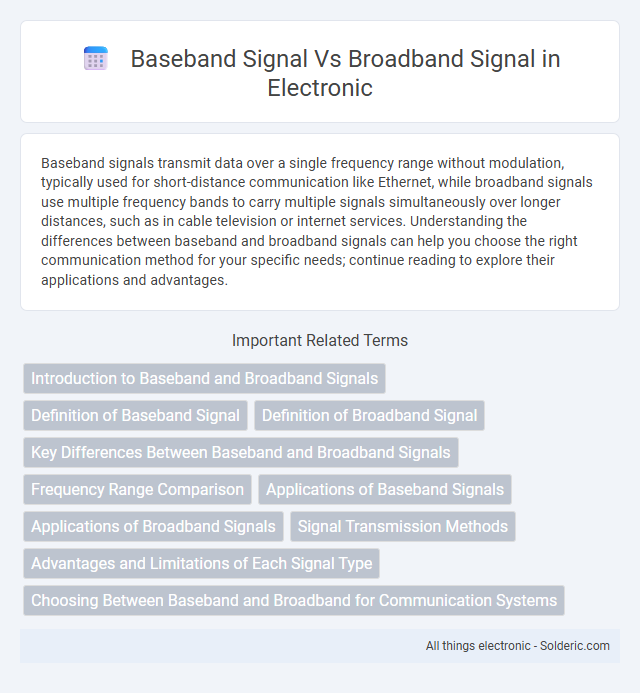Baseband signals transmit data over a single frequency range without modulation, typically used for short-distance communication like Ethernet, while broadband signals use multiple frequency bands to carry multiple signals simultaneously over longer distances, such as in cable television or internet services. Understanding the differences between baseband and broadband signals can help you choose the right communication method for your specific needs; continue reading to explore their applications and advantages.
Comparison Table
| Feature | Baseband Signal | Broadband Signal |
|---|---|---|
| Definition | Signals transmitted over the entire bandwidth of the medium | Signals divided into multiple frequency channels for simultaneous transmission |
| Frequency Range | Uses low-frequency range (near zero to max frequency) | Uses multiple high-frequency channels within the available bandwidth |
| Modulation | Typically unmodulated or digitally modulated | Uses frequency-division multiplexing (FDM) |
| Transmission Medium | Common in wired media like Ethernet LAN | Common in cable TV and broadband internet |
| Data Rate | Limited to one signal at a time | Supports multiple signals simultaneously, higher overall data capacity |
| Signal Range | Usually short-distance, limited by attenuation | Supports longer distances with amplification |
| Application | LAN communication, digital data transfer | Multimedia, internet, cable TV transmission |
Introduction to Baseband and Broadband Signals
Baseband signals occupy the frequency range from near zero up to a maximum frequency, typically representing raw data or unmodulated signals transmitted over a single channel like Ethernet or telephone lines. Broadband signals span a wide range of frequencies, allowing simultaneous transmission of multiple signals by dividing the bandwidth into several channels, commonly used in cable TV and internet communications. The fundamental difference lies in baseband utilizing the entire channel bandwidth for one signal while broadband divides it to carry multiple signals concurrently.
Definition of Baseband Signal
A baseband signal refers to a signal that occupies the frequency range starting from near zero Hz up to a certain maximum frequency without modulation. This type of signal is typically used in digital communication systems such as Ethernet and involves transmitting data in its original form over the medium. Unlike broadband signals that use modulation to transmit multiple channels at different frequencies, baseband signals transmit a single channel directly.
Definition of Broadband Signal
A broadband signal transmits multiple frequencies simultaneously over a wide range of the electromagnetic spectrum, enabling high data rates and efficient utilization of bandwidth. Unlike baseband signals, which occupy a single frequency band and require conversion for long-distance transmission, broadband signals support multiple channels through frequency division multiplexing. Your communication systems benefit from broadband signals by enabling faster and more reliable data transfer across diverse applications like cable TV, internet, and wireless networks.
Key Differences Between Baseband and Broadband Signals
Baseband signals transmit data over a single channel using low-frequency range, ideal for short-distance communication like Ethernet cables, while broadband signals utilize multiple frequency bands simultaneously for long-distance and high-capacity transmissions such as cable TV and internet. The main differences lie in their bandwidth usage, with baseband being narrowband requiring direct connection, whereas broadband supports multiple channels over a single medium. Your choice between baseband and broadband depends on the required transmission distance, data capacity, and application environment.
Frequency Range Comparison
Baseband signals occupy a frequency range starting from near zero Hertz up to a maximum frequency that defines the signal bandwidth, typically confined to the original frequency spectrum of the transmitted information. Broadband signals encompass a much wider frequency range, often spanning several megahertz to gigahertz, allowing simultaneous transmission of multiple channels or data streams. This frequency range difference makes baseband ideal for short-distance, low-frequency applications, while broadband suits high-capacity, long-distance communications.
Applications of Baseband Signals
Baseband signals are primarily used in applications such as digital communication systems, including Ethernet and local area networks (LANs), where data is transmitted without modulation over short distances. These signals are essential for wired communication technologies, enabling high-speed data transfer with minimal interference. Common use cases include audio and video transmission within electronic devices and control systems in industrial automation.
Applications of Broadband Signals
Broadband signals are essential in high-speed internet communication, facilitating data transmission over wide frequency ranges in fiber optic and cable networks. They support multimedia streaming, video conferencing, and online gaming by enabling high bandwidth and low latency connections. Telecommunications systems rely on broadband signals to efficiently carry multiple channels simultaneously, enhancing network capacity and service quality.
Signal Transmission Methods
Baseband signal transmission sends data using a single channel over the entire bandwidth, typically using digital or pulse signals suitable for short-distance communication like Ethernet. Broadband signal transmission divides the bandwidth into multiple channels by modulation, allowing simultaneous transmission of different signals over longer distances via cable or wireless systems. Understanding these signal transmission methods helps you choose the right technology for efficient data communication based on distance and frequency requirements.
Advantages and Limitations of Each Signal Type
Baseband signals offer simplicity and low transmission costs by using the original frequency range for communication, making them ideal for short-distance data transmission like Ethernet networks. Broadband signals enable simultaneous multiple channel transmissions over a wider frequency spectrum, supporting longer distances and higher data rates but requiring more complex modulation and hardware. Your choice depends on the application's needs for bandwidth efficiency, transmission distance, and equipment complexity.
Choosing Between Baseband and Broadband for Communication Systems
Choosing between baseband and broadband communication systems depends on factors such as bandwidth availability, distance requirements, and interference tolerance. Baseband signals, which transmit a single frequency over a medium, are ideal for short-distance, low-interference environments like Ethernet networks. Broadband signals support multiple frequency bands simultaneously, making them suitable for long-distance communication with higher data rates and complex transmission needs like cable TV and internet services.
baseband signal vs broadband signal Infographic

 solderic.com
solderic.com